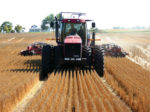Advertise Follow Us
Items Tagged with 'tire'
ARTICLES
Controlled Traffic's Benefits Piling Up
Research worldwide shows these systems can boost yields and soil health, and starting the practice in the U.S. isn't as difficult as many no-tillers think.
Read More
“Highways” May Cure Compaction
Running equipment on the same path in no-till fields gives rootbeds space to develop and may even increase yields, researchers say.
Read More
Combating Compaction: Tires Or Tracks?
Careful Selection of New Tires or Tracks can Reduce the Yield Robbing Effects of Soil COmpaction
Read More








